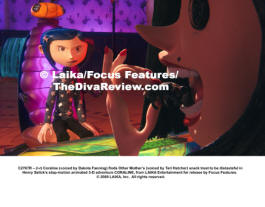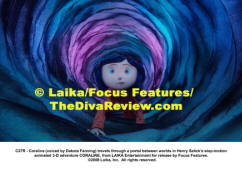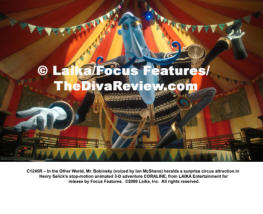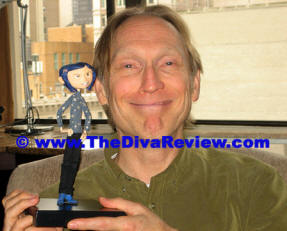
Hey babies, such a great pleasure to sit for an exclusive chat with the modern master of stop-motion animation, Henry Selick, creator of such classics as Nightmare Before Christmas and James and the Giant Peach. I had so much to say about his latest breathtaking masterpiece, Coraline, but something stopped me in my tracks as I walked into the room and realised Mr. Selick had brought a surprise guest with him.
Coraline - Henry Selick
 The
Lady Miz Diva: Mr.
Selick, itís so nice to meet you. I think Coraline is Ö *Gasp*
The
Lady Miz Diva: Mr.
Selick, itís so nice to meet you. I think Coraline is Ö *Gasp*
Henry Selick: There she is! {Holds up Coraline scale model from her own perch beside him}
LMD: Just stops a conversation cold, doesnít she? And sheís wearing her Other Mother outfit! What are the seams across her face just under her eyes?
HS: Actually, in the whole movie theyíre there in order to give her a huge range of expressions: We decided to split the upper and lower face so we could change the mouth separately from changing eyebrows. And some folks, including myself, wanted to leave that in the film because itís something you see right away and then in five minutes, it disappears. But other folks were concerned it would be too conspicuous, so we painted it out.
 LMD:
In every film you invent some new technique or technology to get the
result youíre aiming for. Was getting that amazing variety of facial
expressions for each character the challenge for Coraline?
LMD:
In every film you invent some new technique or technology to get the
result youíre aiming for. Was getting that amazing variety of facial
expressions for each character the challenge for Coraline?
HS: One of the challenges in Coraline was to give the puppets a range of acting beyond anything done before. Coraline the movie exists in this place between live-action and cartoon animation. Coralineís in virtually every scene in the film, she needed to be able to be emotional; be able to say anything and say it whether sheís in a good humour or ill humour, be skeptical, pouty - sheís a lot of things. Going back to Jack Skellington, thereís something called replacement animation, where you basically sculpt every expression separately and in-betweens. Jack was basically a ping-pong ball with a couple holes and no eyeballs and we were able to sculpt a whole series of faces and the sculptures worked with a little video camera, so theyíd know, ĎWell, this has to line up with this.í We had to go farther and we had done some face masks, replacement masks for Miss Spider in James and the Giant Peach. In order to get enough expression, we decided to split the face and I worked with this brilliant guy, Martin Meunier, with Brian McLean, and they came up with a way to help generate in-betweens. Weíd start with just drawings; we wanted good, strong shapes for mouths. I wanted her face to be very asymmetrical, things pulled over to one side, but those guys came up using rapid prototype 3D printers, to come up with in-betweens, so we didnít have to hand-sculpt everything. We could literally print three-dimensionally a lot of these faces. I know it sounds crazy.
LMD: Well, thatís another thing thatís new for your filmmaking. Could you talk about the process of shooting stereoscopically and choosing to make Coraline a 3D feature?
HS: Itís the first stop-motion feature shot stereoscopically. It is what the experts like to call it, they donít like 3D, but I can never say it. You do it! {Laughs} Shooting in 3D was a way to capture the essence of stop-motion, that itís real puppets, real sets, real props. It was a way to pull people into this world in the way Coraline is pulled into this Other World. So, we didnít go for a lot of eye-poking gimmicks, but it was more about creating a world to look in at and have depth.
 LMD:
One of the things that grabbed me about Coraline is how textural it is;
you really feel as if youíre falling into the Other World with
Coraline. It seemed like a lot of the sets and backgrounds were
inspired by classic art, whether it was Toulouse Lautrec or Escher or
Van Gogh. I wondered if there were conscious or specific art influences
you recalled while deciding on the look of the different scenes?
LMD:
One of the things that grabbed me about Coraline is how textural it is;
you really feel as if youíre falling into the Other World with
Coraline. It seemed like a lot of the sets and backgrounds were
inspired by classic art, whether it was Toulouse Lautrec or Escher or
Van Gogh. I wondered if there were conscious or specific art influences
you recalled while deciding on the look of the different scenes?
 HS:
The Mouse Circus in particular, is one of those things it just ended up
looking like Toulouse Lautrecís work, but itís partly subject matter,
colour, colour choices and the lighting there, which I think is
beautiful. Thereís very few things in a film where you can say, ĎOh,
itís exactly based on something else.í We had one key concept artist,
Tadahiro Uesugi, but thereís hardly anything in the movie that looks
just like his illustrations, because his illustrations are about shape,
line and colour, and theyíre very graphic, theyíre very flat, and
everything we build has to have dimension. So, itís really hard to make
the two things look alike. But there are a few moments when Coraline is
trying to escape from the Other World, when sheís running through the
orchard and then everything changes shape and fades to white, and thatís
exactly like one of Tadahiroís illustrations. But there was an essence
in his work that even if we couldnít really bring that into 3D in
colour, in shape, in line quality, that we did very much hold onto. So,
itís just this process, you start with something, people, other artists
- I had other great illustrators and three art directors, with a fourth
added for the fantastic garden - everyone interprets and Iím there
nudging, sketching. Iíve lived with the project so long I basically
just know what fits in the world and what doesnít, and I canít even
explain it; itís just who I am and what my sensibilities are with all
the contributions of all these incredible artists in the process of
making the film.
HS:
The Mouse Circus in particular, is one of those things it just ended up
looking like Toulouse Lautrecís work, but itís partly subject matter,
colour, colour choices and the lighting there, which I think is
beautiful. Thereís very few things in a film where you can say, ĎOh,
itís exactly based on something else.í We had one key concept artist,
Tadahiro Uesugi, but thereís hardly anything in the movie that looks
just like his illustrations, because his illustrations are about shape,
line and colour, and theyíre very graphic, theyíre very flat, and
everything we build has to have dimension. So, itís really hard to make
the two things look alike. But there are a few moments when Coraline is
trying to escape from the Other World, when sheís running through the
orchard and then everything changes shape and fades to white, and thatís
exactly like one of Tadahiroís illustrations. But there was an essence
in his work that even if we couldnít really bring that into 3D in
colour, in shape, in line quality, that we did very much hold onto. So,
itís just this process, you start with something, people, other artists
- I had other great illustrators and three art directors, with a fourth
added for the fantastic garden - everyone interprets and Iím there
nudging, sketching. Iíve lived with the project so long I basically
just know what fits in the world and what doesnít, and I canít even
explain it; itís just who I am and what my sensibilities are with all
the contributions of all these incredible artists in the process of
making the film.
LMD: Have you worked with the same animation team since your days at MTV?
HS: With the crew for Coraline, which was actually a very large crew, one-third of it were original team members, people who go back to MTV, Pillsbury Dough Boy commercials and then Nightmare Before Christmas, James and the Giant Peach. And then a third were people from Portland, Oregon, with a history with the Wil Vinton animation companies. And then one third was the international crew, a lot of Brits, some Kiwis, people from Canada. You know, thereís not that many people doing stop-motion in the world, so you have to reach your arms out and try to bring in the best and brightest from wherever they come from.
LMD: Youíve sort of become the Godfather of stop-motion. Whenever stop-motion animation is discussed now, itís your work thatís referenced. What is it that stop-motion gives you? I know youíve done a CGI short, would you consider doing a CGI or a 2D feature?
HS: I made a living for a short time as a 2D animator at Disney. I came from drawing, but I also did photography and sculpture and these other things. Iíve dabbled in live-action and drawn animation and Iíve done some CG, itís just my preference is stop-motion; itís what I like doing the most. The crew Ö youíre out there on these real sets. Itís sort of like live-action, but in miniature, and instead of everything happening at once, you divide the film into these little units, because you couldnít possible work with just one group of people, you have to divide it up and have many animators, but thereís a pace to it. Every day is like Christmas. Every day thereís a miracle to find: Thereís a shot thatís come in, thereís a new puppet outfit thatís been created, thereís something in edit, we just got the storyboards worked out for this sequence. So, itís the world I love the most. I also think itís a unique experience for the audience. Some people might not even know the difference, they just say, ďWell, itís animation,Ē but I think it gives them a different feeling, the same feeling I had when I saw Ray Harryhausenís charming monsters in his films when I was a little kid, things that have haunted me my whole life.
LMD: You mentioned living with Coraline for such a long time. You actually got a hold of the original Neil Gaiman novel months before it was published. Did you know from your first read that it was special, that you wanted to make a film of the story?
HS: I got the manuscript, it wasnít published Ė in fact there wasnít a publishing deal. I think that Neilís lit agent, Merrilee Heifetz said that there was the same fear and reluctance that I faced a lot with the movie, Neil faced, ĎWell, is it too scary for kids, but not scary enough for his adult audience?í I met him, I read it, and as I was reading it, right away I saw it as a film. Now, it took a long time, it took plenty of rewrites to get a screenplay that worked. It had a lot of growing pains. I did other things along the way to earn a living. I worked on Wes Andersonís film to do some creatures for Life Aquatic {with Steve Zissou}. But everything sort of worked out at the right time; I wanted to use 3D, but five years ago, there were no 3D theatres. Now, we have enough to do a release in them. Yeah, right from the start I saw the movie. Itís grown and changed, but itís still pretty darn close to the first impression.
 LMD:
I must ask who came up with Coralineís blue hair?
LMD:
I must ask who came up with Coralineís blue hair?
HS: I did! I wanted her to be - in the Real World - I wanted her to have some colour. I tried all these colours on her, but it was that blue with her yellow raincoat walking in the gray, dreary outside scenes that just seemed to work.
LMD: Has Neil Gaiman seen this yet?
HS: Yup! I took him the finished film about two weeks ago and presented it to his family and friends in St. Paul, Minnesota, which is not far from where he lives.
LMD: I take it he approved?
HS: He approves. Ask him yourself, but I think he was very happy with it.
LMD: The Nightmare Before Christmas has acquired a very hardcore fandom since it was first released in 1993, but the Japanese really embraced from the start and toys and fashion based on that film are still in demand there today. Are you surprised at that rabid response?
HS: I feel kids there actually connected. {Hayao} Miyazaki, their animation director, is one of my favourites; I feel more in tune with his sensibilities. So, Iím not that surprised, Iím very happy. Iím hoping they feel the same about Coraline.
Special thanks to our beloved Dollie Banner for her invaluable assistance with the interview.
~ The Lady Miz Diva
January 13th, 2009
PS: Hey Kids, click here to read our rave movie review of Coraline.
© 2006-2022 The Diva Review.com
|